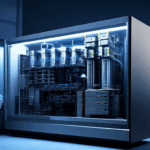“`html
Harnessing Power: How Machine Learning and Deep Learning Are Reshaping Industries
Introduction
Machine learning (ML) and deep learning (DL) have emerged as pivotal technologies in the realm of artificial intelligence, driving significant advancements across numerous industries. These methodologies enable computers to learn from data, identify patterns, and make decisions with minimal human intervention. As data volumes continue to grow exponentially, the demand for sophisticated analytical tools has surged, making ML and DL indispensable in modern technology.
The transformative potential of these technologies is evident in sectors ranging from healthcare and finance to manufacturing, retail, transportation, and energy. By leveraging ML and DL, businesses can optimize operations, enhance decision-making, and deliver personalized experiences to customers. This article delves into the applications, benefits, challenges, and future outlook of ML and DL, illustrating their profound impact on reshaping industries.
Applications of Machine Learning and Deep Learning
Healthcare
In healthcare, ML and DL are revolutionizing diagnostics, drug discovery, personalized medicine, and patient care. For instance, DL algorithms can analyze medical images, such as X-rays and MRIs, with greater accuracy than human radiologists. Additionally, ML models are employed in drug discovery to predict molecular interactions and accelerate the development of new treatments. Personalized medicine leverages patient-specific data to tailor therapies, enhancing treatment efficacy and reducing adverse effects.
Finance
The financial sector is another domain where ML and DL are making waves. Fraud detection systems powered by ML can analyze transaction patterns in real-time, identifying suspicious activities with high precision. Algorithmic trading relies on ML models to execute trades based on market data, optimizing returns while minimizing risks. Risk assessment models use historical data to predict creditworthiness, enabling more accurate lending decisions. Customer service automation, such as chatbots and virtual assistants, enhances user experiences and reduces operational costs.
Manufacturing
Manufacturing processes benefit significantly from ML and DL through predictive maintenance, quality control, and supply chain optimization. Predictive maintenance uses sensor data to anticipate equipment failures, reducing downtime and maintenance costs. Quality control systems employ image recognition to detect defects in products, ensuring higher standards of output. Supply chain optimization leverages ML to forecast demand, manage inventory levels, and streamline logistics, thereby improving efficiency and reducing waste.
Retail
Retailers harness ML and DL to improve customer experiences and optimize operations. Recommendation systems suggest products based on user preferences and purchase history, increasing sales and customer satisfaction. Inventory management systems use ML to predict demand, preventing stockouts and overstock situations. Customer segmentation allows retailers to target specific demographics with tailored marketing campaigns, enhancing engagement and loyalty.
Transportation
The transportation industry is witnessing a paradigm shift with the advent of autonomous vehicles, traffic management, and logistics optimization. Autonomous vehicles rely on DL algorithms to perceive their surroundings, navigate safely, and interact with other road users. Traffic management systems use ML to analyze traffic patterns, optimizing signal timings and reducing congestion. Logistics optimization employs ML to route shipments efficiently, minimizing delivery times and fuel consumption.
Energy
Energy consumption prediction, grid management, and renewable energy integration are key areas where ML and DL are contributing to sustainable practices. Energy consumption prediction models help utilities forecast demand, enabling efficient resource allocation. Grid management systems use ML to monitor and control electricity distribution, ensuring reliability and stability. Renewable energy integration leverages ML to optimize the production and distribution of clean energy sources, promoting environmental sustainability.
Benefits of Machine Learning and Deep Learning
The adoption of ML and DL yields numerous benefits, including increased efficiency and productivity, enhanced decision-making through data analysis, personalization and improved customer experiences, and cost savings through automation and predictive analytics. These technologies empower organizations to make informed decisions, automate routine tasks, and deliver tailored solutions, ultimately driving growth and innovation.
Challenges and Limitations
Despite their transformative potential, ML and DL face several challenges and limitations. Data privacy and security concerns arise as sensitive information is processed and stored. Ethical considerations, such as bias in algorithms, necessitate careful monitoring and regulation. High computational costs and resource requirements pose barriers to widespread adoption, particularly for smaller enterprises. The need for skilled professionals and continuous training underscores the importance of developing a competent workforce capable of harnessing these technologies effectively.
Future Outlook
The future of ML and DL holds immense promise, with potential advancements in AI technologies, integration with other emerging technologies like IoT and quantum computing, and predictions on how these technologies will evolve and impact industries further. As research progresses, we can expect more sophisticated algorithms, improved interpretability, and broader applications across diverse sectors. The convergence of ML/DL with IoT and quantum computing will unlock new possibilities, paving the way for smarter cities, personalized healthcare, and optimized industrial processes.
Conclusion
In conclusion, ML and DL are reshaping industries by offering unprecedented opportunities for innovation and growth. From healthcare and finance to manufacturing, retail, transportation, and energy, these technologies are driving efficiency, enhancing decision-making, and delivering personalized experiences. While challenges persist, the transformative power of ML and DL is undeniable. As businesses continue to embrace these technologies, staying informed about advancements in this field will be crucial for remaining competitive and adaptable in the rapidly evolving technological landscape.
“`


